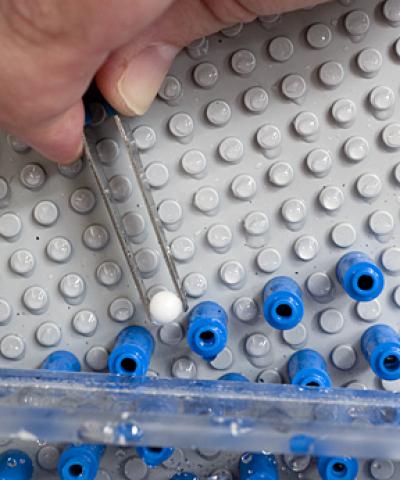LEGO toys and Shrinky Dinks aid in development of microfluidics

Electronic circuits are not the only objects that engineers are scaling down to ever smaller sizes these days. They're also creating devices to work with fluid samples of just a few nanoliters (a nanoliter corresponds to a billionth of a liter).
The field is called microfluidics, and it combines biology, physics, and other disciplines to study the behavior, precise control and manipulation of minute amounts of fluids for a variety of applications. It's used in the development of inkjet printheads, DNA chips, lab-on-a-chip technology, and beyond.
However, this new science poses challenges to research labs, such as funding for expensive equipment to develop microfluidic devices, to understanding how the minuscule forces within them work. Those challenges are being met with a rash of ingenuity among engineers that involve, of all things, everyday toys. Here are two such cases:
LEGO pieces recreate microscopic activity taking place inside lab-on-a-chip (microfuidic arrays)
Johns Hopkins engineers are using LEGO pieces shaped like pegs to visualize the behavior of particles, cells and molecules taking place inside lab-on-a-chip devices at a scale that can more easily be observed.
The team is led by Joelle Frechette and German Drazer, both assistant professors of chemical and biomolecular engineering in the university's Whiting School of Engineering. They used beads just a few millimeters in diameter, an aquarium filled with goopy glycerol and the LEGO pieces arranged on a LEGO board to unlock mysteries occurring at the micro or nanoscale level. Their observations could offer clues on how to improve the design and fabrication of lab-on-a-chip technology. Their study concerning this technique was published in Physical Review Letters.
The idea for this project comes from the concept of "dimensional analysis," in which a process is studied at a different size and time scale while keeping the governing principles the same.
Frechette said, "Microfluidic arrays are like miniature chemical plants. One of the key components of these devices is the ability to separate one type of constituent from another. We investigated a microfluidic separation method that we suspected would remain the same when you scale it up from micrometers or nanometers to something as large as the size of billiard balls."
So with that goal in mind, Frechette and Drazer constructed an array using cylindrical LEGO pegs stacked two high and arranged in rows and columns on a LEGO board to create a lattice of obstacles. The board was attached to a Plexiglas sheet to improve its stiffness and pressed up against one wall of a Plexiglas tank filled with glycerol. Stainless steel balls of three different sizes, as well as plastic balls (pictured above), were manually released from the top of the array; their paths to the bottom were tracked and timed with a camera. This allowed the researchers to visualize what happens at nanoscale in microfluidic arrays.
The entire setup, Drazer said, cost a few hundred dollars and could easily be replicated as a science fair experiment.
"Baking" microfluidic arrays with Shrinky Dinks
Michelle Khine, a biomedical engineer at the University of California, Irvine, didn't have the patience to wait for a $100,000 specialized machine to make microfluidic chips, so with some inspiration to find a low-cost solution, she turned to her favorite childhood toy: Shrinky Dinks, large sheets of thin plastic that can be colored with paint or ink and then shrunk in a hot oven (Shrinky Dink video).
"I thought if I could print out the [designs] at a certain resolution and then make them shrink, I could make channels the right size for microfluidics," Khine toldTechnology Review.
To test her idea, she created a channel design in AutoCAD, printed it out on Shrinky Dink material using a laser printer, and stuck the result in a toaster oven. (In a video interview, Khine explains how she uses Shrinky Dinks to make high-tech diagnostic chips.)
According to Technology Review, as the plastic shrank, the ink particles on its surface clumped together and formed tiny ridges, exactly the effect Khine wanted. Then she poured a flexible polymer known as PDMS onto the surface of the cooled Shrinky Dink and the ink ridges created tiny channels in the surface of the polymer as it hardened. She pulled the PDMS away from the Shrinky Dink mold to reveal a finished microfluidic device that cost less than a fast-food meal.
Khine's breakthrough has been met with both praise and skepticism from the scientific community and it's not without glitches. Nevertheless, she plans to use her chips to detect various medical conditions and hopes that it will eventually lead to cheap and portable devices that will someday be used to diagnose HIV and other infections. Khine also managed to print metal patterns on Shrinky Dinks, and that could help make solar cells more efficient.
"We haven't come close to pushing the limits of this technology yet," she said.
